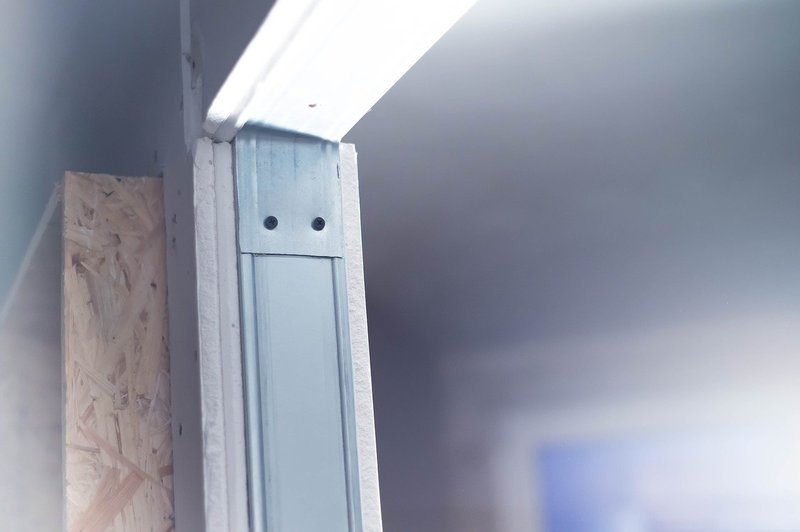This article will highlight what is the best mold-resistant drywall. One of the characteristics of an ideal mold-resistant material for drywalls is those without organic backing.
Use non-paper material like fiberglass to ensure that you do not invite mold.

This article outlines several points regarding mold, drywall, and protective measures. If you’re interested in learning more about drywalls and mold, please read this article until the end!
Mold And Drywall
Mold is sneaky. It can get in even in the most inaccessible places of your home because mold spores are everywhere.
Then, these mold spores settle on your surfaces, especially if it is rich in moisture. Another reason for mold growth in inaccessible places is a food source.
For standard drywalls, their paper backing serves as a food source for mold. Couple this with moisture, and you get mold contamination.
Also, the inaccessibility (behind the wall) helps in the proliferation of mold because they are harder to detect. Here is an article outlining how to identify mold from behind your wall if you need it.
Drywalls are widely used in home construction. In this article, you’ll learn about the best mold-resistant drywall in the market.
Why choose mold-resistant drywall?
As mentioned above, mold is a tricky household problem. Sometimes, you wouldn’t notice your mold problem until it’s too late.
Typically, undetected water damage leads to inconspicuous mold growth. Here is an article that may help you detect water damage before it turns into mold contamination.
For the water damage reason alone, it would be best to choose mold-resistant materials. If you protect your home from a mold problem using these objects, then your house will last longer.
Are mold-resistant materials safe?
Most mold-resistant drywall is safe. However, you still have to be a responsible consumer and do your research.
Some mold-resistant drywalls use toxic materials to protect them from mold. While it protects you from fungi, it may pose other health issues for your family.
Things to consider when choosing materials
An expensive material isn’t necessarily the best one for the job. You have to consider several factors when you’re choosing a mold-resistant drywall for your home.
First, consider your location. Then, check your material’s compatibility with your home’s weather — whether it’s humid or not.
Another factor you ought to consider is how the overall system drains and dries. Despite choosing a mold-resistant material, you still need to follow mold prevention measures.
Tips for mold prevention
One of the basic mold prevention measures is preventing leaks. A way to protect your home from unwanted leaks is by maintaining your roof.
Your roof is the first form of defense against the harsh elements, and they’re subject to water damage and mold growth. Hence, you have to be sure to check your roof before and after a big storm.
Another tip is to seal your windows. Your windows’ caulks are subjected to the weather as well; it’s essential to give them attention as well.
If your window seals are broken, outside water either from the rain or gutter may get inside. This would affect both your windows and adjacent walls.
Later on, these forms of water damage would lead to mold contamination. So, it’s important to remember these protective measures.
The Best Mold-Resistant Drywall
Right now, the best mold-resistant drywall should have a non-paper-faced gypsum wallboard. That, or you can pick drywall with a water-resistant fiberglass gypsum panel or wallboard.
Those characteristics mentioned above would protect your drywall from mold and moisture compared to a regular one with paper. The advantage of regular drywall is that it is light, but the paper can serve as a food source to mold.
If you have trouble choosing between non-paper-faced or fiberglass, we recommend the latter. Fiberglass doesn’t have any organic material that may serve as a food source for mold.
The best brands of mold-resistant drywall in the market right now are DensArmor Plus and Humitek. However, if those are not accessible, you can try USG Sheetrock Mold Tough Drywall instead.
A word of caution
Using such materials would lessen your chances of mold contamination, but it won’t entirely prevent it. You still need to be responsible and familiarize yourself with mold prevention procedures.
For additional protection, use other mold-resistant materials aside from drywall. Although, make sure that the ones you use are compatible with each other.
Guide for installation
The installation for mold-resistant drywall is similar to the standard one. First, the drywall panels are nailed on the framing.
Then, you have to cover the joints between the panels with drywall tape. After covering it, coat the joints with several types with a taping compound.
Make sure to sand the surface after each coat. After installing the drywall panels, nail the trim and the baseboards on the installed boards.
Afterward, paint and finish the surface using a wall primer and mold-resistant paint.
Conclusion
We hope this article on what is the best mold-resistant drywall was able to answer your questions regarding mold contamination and drywalls. However, please remember the warnings we indicated regarding its use and the mold prevention measures.
